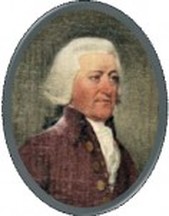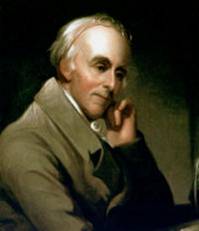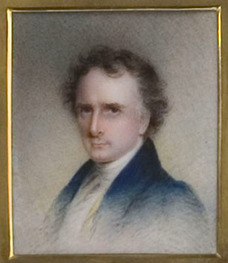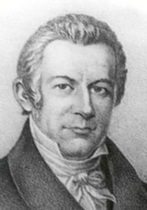TREASURERS

Tristam Dalton
1st Mint Treasurer
1792 - 1794
Tristam Dalton (1732 - 1817), was born in Newburyport, Mass., May 28th, 1738. He attended Dummer Academy, Byfield, Mass., and graduated from Harvard College in 1755. He studied law and was admitted to the bar, but did not practice. Instead, he engaged in mercantile pursuits and became a wealthy businessman like his father Michael Dalton. As a young man he ardently adopted the revolutionary cause. He was a lifelong friend of John Adams, who he studied with while at Harvard. He was a delegate from Massachusetts to the convention of committees of New England Provinces, which met in Providence, R.I., December 25th, 1776. Dalton was also a member of the State house of representatives in 1782-1785, and served as speaker in 1784. At the same time, he was elected to the Continental Congress in 1783 and 1784, but did not attend. After being a member of the State senate from 1785-1788, he was elected to the United States Senate and served from March 4th, 1789, to March 3rd, 1791, although he was an unsuccessful candidate for re-election in 1790. Dalton was appointed as Treasurer of the U. S. Mint in 1792 and remained until he resigned on April 23rd, 1794. In later life, he was eventually reduced to poverty by the Washington, D.C. real estate market crash and the consequences of the War of 1812. Due to a commission arranged by President James Monroe, he was surveyor of the port of Boston, Mass. from November 1814 until his death there on May 30th, 1817. He is buried in the churchyard of St. Paul’s Episcopal Church, Newburyport, Essex County, Mass. He lies buried in the mausoleum he originally built for his mother Mary (Little) (1713-1791) in 1792. His widow Ruth (Hooper) followed him in 1826. She is buried in an anonymous grave on Boston Common. They had no surviving children.
Nicholas Way
2nd Mint Treasurer
1794 - 1797
Dr. Nicholas Way (1746 - 1797) Way had come to Philadelphia from Wilmington in 1794, encouraged by his old friend and classmate, Benjamin Rush and lured by an appointment to a federal government sinecure, as Treasurer of the Mint. He also became one of the city's top obstetricians. He was appointed Treasurer of the Mint on May 20th, 1794, replacing Dalton. During the epidemic of 1797 he organized a group of doctors to visit the poor. He succumbed to the “yellow fever” at the beginning of September 1797 and was buried in the Friends Burial Ground on September 3rd.

Benjamin Rush
3rd Mint Treasurer
1797 – 1813
Dr. Benjamin Rush (1745 - 1813), was born to John Rush and Susanna Hall on December 24th, 1745 in the Township of Byberry in Philadelphia County, which was then about 14 miles outside Philadelphia. The township was incorporated into Philadelphia in 1854, and now remains one of its neighborhoods. His father died when he was six, and Rush spent most of his early life with his maternal uncle, the Reverend Samuel Finley. He attended Finley's academy at Nottingham, which would later become West Nottingham Academy.
In 1760, he completed a five-year program earning him a Bachelor of Arts degree at the College of New Jersey (now Princeton University), and then studied medicine under Dr. John Redman in Philadelphia. Redman encouraged him to further his studies at the University of Edinburgh, where he earned a medical degree. While in Europe practicing medicine, he learned French, Italian, and Spanish. Returning to the Colonies in 1769, Rush opened a medical practice in Philadelphia and became Professor of Chemistry at the College of Philadelphia (now the University of Pennsylvania).
He published the first American textbook on chemistry, several volumes on medical student education, and wrote influential patriotic essays. He was active in the Sons of Liberty and was elected to attend the provincial conference to send delegates to the Continental Congress. He consulted Thomas Paine on the writing of the profoundly influential pro-independence pamphlet, "Common Sense". He was appointed to represent Pennsylvania at the Continental Congress and was one of the signers of the Declaration of Independence.
In 1777, he became surgeon-general of the middle department of the Continental Army. Conflicts with the Army Medical service, specifically with Dr. William Shippen, Jr., led to Rush's resignation in 1778. As General George Washington suffered a series of defeats in the war, Rush campaigned for his removal, as part of the Conway Cabal, losing his trust and ending Rush's war activities. Rush later expressed regret for his actions against Washington. In a letter to John Adams in 1812, Rush wrote, "He [Washington] was the highly favored instrument whose patriotism and name contributed greatly to the establishment of the independence of the United States."
In 1783, he was appointed to the staff of Pennsylvania Hospital, of which he remained a member until his death. He was elected to the Pennsylvania convention, which adopted the Federal constitution. He became Professor of medical theory and clinical practice at the University of Pennsylvania in 1791, though the quality of his medicine was quite primitive even for the time: he advocated bleeding (for almost any illness) long after its practice had declined. He became a social activist, an abolitionist, and was the most well known physician in America at the time of his death. He was also founder of the private liberal arts college Dickinson College, in Carlisle, Pennsylvania.
Rush was also a founding member of the Philadelphia Society for Alleviating the Miseries of Public Prisons (known today as the Pennsylvania Prison Society), which greatly influenced the construction of Eastern State Penitentiary in Philadelphia. He was appointed treasurer of the U.S. Mint on November 20th, 1797, to replace his recently deceased friend Nicholas Way, serving until his death on April 19th, 1813. At his death, he was buried at Christ Church in Philadelphia.
In 1760, he completed a five-year program earning him a Bachelor of Arts degree at the College of New Jersey (now Princeton University), and then studied medicine under Dr. John Redman in Philadelphia. Redman encouraged him to further his studies at the University of Edinburgh, where he earned a medical degree. While in Europe practicing medicine, he learned French, Italian, and Spanish. Returning to the Colonies in 1769, Rush opened a medical practice in Philadelphia and became Professor of Chemistry at the College of Philadelphia (now the University of Pennsylvania).
He published the first American textbook on chemistry, several volumes on medical student education, and wrote influential patriotic essays. He was active in the Sons of Liberty and was elected to attend the provincial conference to send delegates to the Continental Congress. He consulted Thomas Paine on the writing of the profoundly influential pro-independence pamphlet, "Common Sense". He was appointed to represent Pennsylvania at the Continental Congress and was one of the signers of the Declaration of Independence.
In 1777, he became surgeon-general of the middle department of the Continental Army. Conflicts with the Army Medical service, specifically with Dr. William Shippen, Jr., led to Rush's resignation in 1778. As General George Washington suffered a series of defeats in the war, Rush campaigned for his removal, as part of the Conway Cabal, losing his trust and ending Rush's war activities. Rush later expressed regret for his actions against Washington. In a letter to John Adams in 1812, Rush wrote, "He [Washington] was the highly favored instrument whose patriotism and name contributed greatly to the establishment of the independence of the United States."
In 1783, he was appointed to the staff of Pennsylvania Hospital, of which he remained a member until his death. He was elected to the Pennsylvania convention, which adopted the Federal constitution. He became Professor of medical theory and clinical practice at the University of Pennsylvania in 1791, though the quality of his medicine was quite primitive even for the time: he advocated bleeding (for almost any illness) long after its practice had declined. He became a social activist, an abolitionist, and was the most well known physician in America at the time of his death. He was also founder of the private liberal arts college Dickinson College, in Carlisle, Pennsylvania.
Rush was also a founding member of the Philadelphia Society for Alleviating the Miseries of Public Prisons (known today as the Pennsylvania Prison Society), which greatly influenced the construction of Eastern State Penitentiary in Philadelphia. He was appointed treasurer of the U.S. Mint on November 20th, 1797, to replace his recently deceased friend Nicholas Way, serving until his death on April 19th, 1813. At his death, he was buried at Christ Church in Philadelphia.

James Rush
4th Mint Treasurer
1813 – 1830
Dr. James Rush (1786 - 1869), was the seventh child of Dr. Benjamin Rush and Julia Stockton. Following in the footsteps of his father, he studied at both Princeton University and at Edinburgh. After returning to Philadelphia, he obtained his M.D. from the University of Pennsylvania in 1809. In 1819, James married Phoebe Anne Ridgway (1799-1857), daughter of the wealthy Philadelphia merchant Jacob Ridgway (1768-1843). Rush and his wife resided on Chestnut Street, west of 19th street in Philadelphia, in a home that James Rush had designed and built. It was at this house, which was large enough to accommodate approximately eight hundred guests, that they threw some of the most lavish parties in Philadelphia. After the death of her father, Phoebe inherited an estate worth over a million dollars, which after her death in 1857, was passed to her husband.
On April 27th, 1813, he was appointed Treasurer of the United States Mint, replacing his father. He held this post until resigning on September 12th, 1830. He retired from public life after only a short time, to pursue his literary and scientific interests. He published several books, the most well known of which was "The Philosophy Of The Human Voice: Embracing Its Physiological History; Together With A System Of Principles...", which was published in six revised editions during his lifetime. After his death, Rush left his estate to found the Ridgway Branch of the Library Company of Philadelphia. His estate was administered by his brother-in-law, Henry J. Williams.
On April 27th, 1813, he was appointed Treasurer of the United States Mint, replacing his father. He held this post until resigning on September 12th, 1830. He retired from public life after only a short time, to pursue his literary and scientific interests. He published several books, the most well known of which was "The Philosophy Of The Human Voice: Embracing Its Physiological History; Together With A System Of Principles...", which was published in six revised editions during his lifetime. After his death, Rush left his estate to found the Ridgway Branch of the Library Company of Philadelphia. His estate was administered by his brother-in-law, Henry J. Williams.

William Findlay
5th Mint Treasurer
1830 – 1845
Hon. William Findlay (1768 - 1846) Findlay, the fourth Governor of Pennsylvania under the Constitution of 1790, from December 16th, 1817, to December 19th, 1820, was born at Mercersburg, Franklin County, June 20th, 1768. He commenced life as a farmer, on a portion of his father's estate, which he inherited at the death of his father in 1799. The first office that he ever held was of Brigade Inspector of militia. In 1797, Findley was elected a member of the House of Representatives of the State Legislature and he was again elected to the House in 1803. He proved himself a leading member, and one of the most useful in the House, being placed in the most responsible positions. On January 13th, 1807, he was elected State Treasurer, and was annually re-elected to that office for eleven years, when he resigned to assume the duties of Chief Magistrate.
At the session of the Legislature, 1821-2, Governor Findlay was elected to the Senate of the United States for the full term of six years. At the expiration of his Senatorial term he was then appointed Treasurer of the United States Mint at Philadelphia on September 13th, 1830 and resigned that office on account of the infirmities of age in 1845. He died at Harrisburg, at the residence of his son-in-law, Governor Shunk, November 12th, 1846. Governor Findlay was a very popular man.
At the session of the Legislature, 1821-2, Governor Findlay was elected to the Senate of the United States for the full term of six years. At the expiration of his Senatorial term he was then appointed Treasurer of the United States Mint at Philadelphia on September 13th, 1830 and resigned that office on account of the infirmities of age in 1845. He died at Harrisburg, at the residence of his son-in-law, Governor Shunk, November 12th, 1846. Governor Findlay was a very popular man.